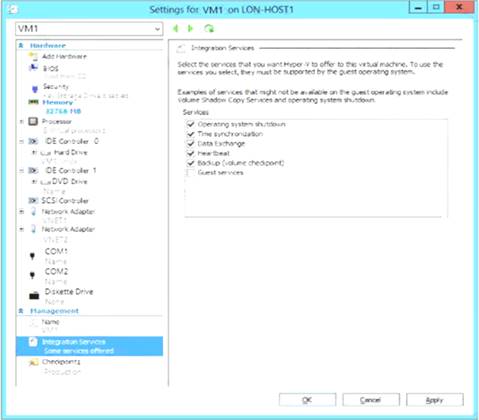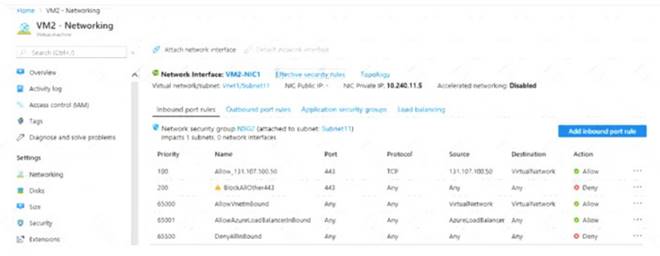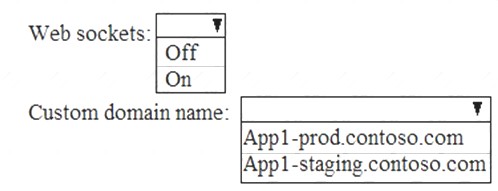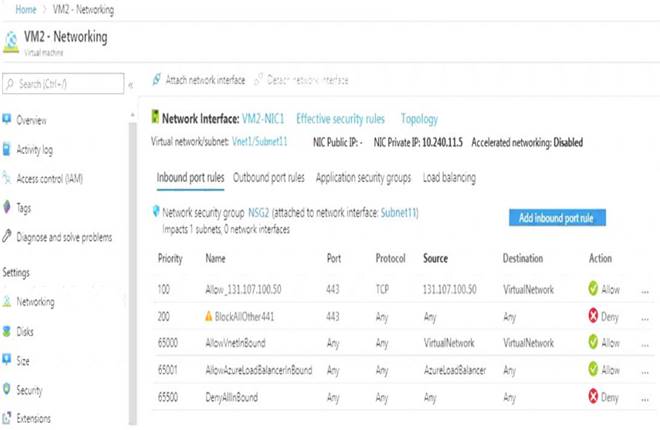
we provide Certified Microsoft AZ-104 brain dumps which are the best for clearing AZ-104 test, and to get certified by Microsoft Microsoft Azure Administrator. The AZ-104 Questions & Answers covers all the knowledge points of the real AZ-104 exam. Crack your Microsoft AZ-104 Exam with latest dumps, guaranteed!
Free AZ-104 Demo Online For Microsoft Certifitcation:
NEW QUESTION 1
Which blade should you instruct the finance department auditors to use?
Answer: D
Explanation:
You can opt in and configure additional recipients to receive your Azure invoice in an email. This feature may not be available for certain subscriptions such as support offers, Enterprise Agreements, or Azure in Open. Select your subscription from the Subscriptions page. Opt-in for each subscription you own. Click Invoices then Email my invoice.
Select your subscription from the Subscriptions page. Opt-in for each subscription you own. Click Invoices then Email my invoice. Click Opt in and accept the terms.
Click Opt in and accept the terms.
Scenario: During the testing phase, auditors in the finance department must be able to review all Azure costs from the past week.
References: https://docs.microsoft.com/en-us/azure/billing/billing-download-azure-invoice-daily-usage-date
NEW QUESTION 2
Note: This question is part of a series of questions that present the same scenario. Each question in the series contains a unique solution that might meet the stated goals. Some question sets might have more than one correct solution, while others might not have a correct solution.
After you answer a question in this section, you will NOT be able to return to it. As a result, these questions will not appear in the review screen.
Your company registers a domain name of contoso.com.
You create an Azure DNS zone named contoso.com, and then you add an A record to the zone for a host named www that has an IP address of 131.107.1.10.
You discover that Internet hosts are unable to resolve www.contoso.com to the 131.107.1.10 IP address. You need to resolve the name resolution issue.
Solution: You modify the name servers at the domain registrar. Does this meet the goal?
Answer: A
Explanation:
Modify the Name Server (NS) record. References:
https://docs.microsoft.com/en-us/azure/dns/dns-delegate-domain-azure-dns
NEW QUESTION 3
You have an Azure subscription.
You have an on-premises virtual machine named VM1. The settings for VM1 are shown in the exhibit. (Click the Exhibit button.)
You need to ensure that you can use the disks attached to VM1 as a template for Azure virtual machines. What should you modify on VM1?
Answer: D
Explanation:
From the exhibit we see that the disk is in the VHDX format.
Before you upload a Windows virtual machines (VM) from on-premises to Microsoft Azure, you must prepare the virtual hard disk (VHD or VHDX). Azure supports only generation 1 VMs that are in the VHD file format and have a fixed sized disk. The maximum size allowed for the VHD is 1,023 GB. You can convert a generation 1 VM from the VHDX file system to VHD and from a dynamically expanding disk to fixed-sized.
References:
https://docs.microsoft.com/en-us/azure/virtual-machines/windows/prepare-for-upload-vhd-image?toc=/azure
NEW QUESTION 4
Note: This question is part of a series of questions that present the same scenario. Each question in the series contains a unique solution that might meet the stated goals. Some question sets might have more than one correct solution, while others might not have a correct solution.
After you answer a question in this section, you will NOT be able to return to it. As a result, these questions will not appear in the review screen.
You have an app named App1 that is installed on two Azure virtual machines named VM1 and VM2. Connections to App1 are managed by using an Azure Load Balancer.
The effective network security configurations for VM2 are shown in the following exhibit.
You discover that connections to App1 from 131.107.100.50 over TCP port 443 fail. You verify that the Load Balancer rules are configured correctly.
You need to ensure that connections to App1 can be established successfully from 131.107.100.50 over TCP port 443.
Solution: You create an inbound security rule that allows any traffic from the AzuteLoadBalancer source and has a cost of 150.
Does this meet the goal?
Answer: B
NEW QUESTION 5
You have an Azure virtual machine named VM1. Azure collects events from VM1.
You are creating an alert rule in Azure Monitor to notify an administrator when an error is logged in the System event log of VM1.
You need to specify which resource type to monitor. What should you specify?
Answer: B
Explanation:
Azure Monitor can collect data directly from your Azure virtual machines into a Log Analytics workspace for
analysis of details and correlations. Installing the Log Analytics VM extension for Windows and Linux allows Azure Monitor to collect data from your Azure VMs.
Azure Log Analytics workspace is also used for on-premises computers monitored by System Center Operations Manager.
Reference:
https://docs.microsoft.com/en-us/azure/azure-monitor/learn/quick-collect-azurevm
NEW QUESTION 6
You have an Azure virtual machine named VM1.
You use Azure Backup to create a backup of VM1 named Backup1. After creating Backup1, you perform the following changes to VM1: Modify the size of VM1.
Modify the size of VM1. Copy a file named Budget.xls to a folder named Data.
Copy a file named Budget.xls to a folder named Data. Reset the password for the built-in administrator account.
Reset the password for the built-in administrator account.  Add a data disk to VM1.
Add a data disk to VM1.
An administrator uses the Replace existing option to restore VM1 from Backup1. You need to ensure that all the changes to VM1 are restored.
Which change should you perform again?
Answer: D
Explanation:
The scenario mentioned in the question, we are using the replace option. So in this case we would lose the existing data written to the disk after the backup was taken. The file was copied to the disk after the backup was taken. Hence, we would need to copy the file once again.
References:
https://docs.microsoft.com/en-us/azure/backup/backup-azure-arm-restore-vms#replace-existing-disks
NEW QUESTION 7
You need to define a custom domain name for Azure AD to support the planned infrastructure. Which domain name should you use?
Answer: BD
Explanation:
Every Azure AD directory comes with an initial domain name in the form of domainname.onmicrosoft.com. The initial domain name cannot be changed or deleted, but you can add your corporate domain name to Azure AD as well. For example, your organization probably has other domain names used to do business and users who sign in using your corporate domain name. Adding custom domain names to Azure AD allows you to assign user names in the directory that are familiar to your users, such as ‘alice@contoso.com.’ instead of 'alice@domain name.onmicrosoft.com'.
Scenario:
Network Infrastructure: Each office has a local data center that contains all the servers for that office. Each office has a dedicated connection to the Internet.
Humongous Insurance has a single-domain Active Directory forest named humongousinsurance.com Planned Azure AD Infrastructure: The on-premises Active Directory domain will be synchronized to Azure
AD.
References: https://docs.microsoft.com/en-us/azure/active-directory/fundamentals/add-custom-domain
NEW QUESTION 8
Note: This question is part of a series of questions that present the same scenario. Each question in the series contains a unique solution that might meet the stated goals. Some question sets might have more than one correct solution, while others might not have a correct solution.
After you answer a question in this section, you will NOT be able to return to it. As a result, these questions will not appear in the review screen.
You have an Azure subscription that contains the virtual machines shown in the following table.
You deploy a load balancer that has the following configurations:  Name: LB1
Name: LB1 Type: Internal
Type: Internal  SKU: Standard
SKU: Standard Virtual network: VNET1
Virtual network: VNET1
You need to ensure that you can add VM1 and VM2 to the backend pool of LB1.
Solution: You create a Standard SKU public IP address, associate the address to the network interface of VM1, and then stop VM2.
Does this meet the goal?
Answer: B
Explanation:
A Backend Pool configured by IP address has the following limitations:  Standard load balancer only
Standard load balancer only
Reference:
https://docs.microsoft.com/en-us/azure/load-balancer/backend-pool-management
NEW QUESTION 9
You have an Azure subscription that contains an Azure Service Bus named Bus1.
Your company plans to deploy two Azure web apps named App1 and App2. The web apps will create messages that have the following requirements: Each message created by App1 must be consumed by only a single consumer
Each message created by App1 must be consumed by only a single consumer  Each message created by App2 will be consumed by multiple consumers.
Each message created by App2 will be consumed by multiple consumers.
Which resource should you create for each web app? To answer, drag the appropriate resources to the correct web apps. Each resource may be used once, more than once, or not at all. You may need to drag the split bar between panes or scroll to view content.
NOTE: Each correct selection is worth one point.
Answer: A
NEW QUESTION 10
You configure Azure AD Connect for Azure Active Directory Seamless Single Sign-On (Azure AD Seamless SSO) for an on-premises network. Users report that when they attempt to access myapps.microsoft.com, they are prompted multiple times to sign in and are forced to use an account name that ends with onmicrosoft.com.
You discover that there is a UPN mismatch between Azure AD and the on-premises Active Directory. You need to ensure that the users can use single-sign on (SSO) to access Azure resources.
What should you do first?
Answer: B
Explanation:
Azure AD Connect lists the UPN suffixes that are defined for the domains and tries to match them with a
custom domain in Azure AD. Then it helps you with the appropriate action that needs to be taken. The Azure AD sign-in page lists the UPN suffixes that are defined for on-premises Active Directory and displays the corresponding status against each suffix. The status values can be one of the following:
State: Verified
Azure AD Connect found a matching verified domain in Azure AD. All users for this domain can sign in by using their on-premises credentials.
State: Not verified
Azure AD Connect found a matching custom domain in Azure AD, but it isn't verified. The UPN suffix of the users of this domain will be changed to the default .onmicrosoft.com suffix after synchronization if the domain isn't verified.
Action Required: Verify the custom domain in Azure AD.
References: https://docs.microsoft.com/en-us/azure/active-directory/hybrid/plan-connect-user-signin
NEW QUESTION 11
You have an Azure virtual machine named VM1 that you use for testing. VM1 is protected by Azure Backup. You delete VM1.
You need to remove the backup data stored for VM1. What should you do first?
Answer: C
Explanation:
Azure Backup provides backup for virtual machines — created through both the classic deployment model and the Azure Resource Manager deployment model — by using custom-defined backup policies in a Recovery Services vault.
With the release of backup policy management, customers can manage backup policies and model them to meet their changing requirements from a single window. Customers can edit a policy, associate more virtual machines to a policy, and delete unnecessary policies to meet their compliance requirements.
NEW QUESTION 12
You have a computer named Computer! that has a point-to site VPN connection to an Azure virtual network named VNet1. The point-to-site connection uses a self-signed certificate.
From Azure, you download and install the VPN client configuration package on a computer named Computer2.
You need to ensure that you can establish a point-to-site VPN connection to VNet1 from Computer2. Solution: You join Computer2 to Azure Active Directory (Azure AD).
Does this meet the goal?
Answer: B
Explanation:
A client computer that connects to a VNet using Point-to-Site must have a client certificate installed. References:
https://docs.microsoft.com/en-us/azure/vpn-gateway/vpn-gateway-certificates-point-to-site
NEW QUESTION 13
You have an Azure subscription that contains an Azure Storage account.
You plan to create an Azure container instance named container1 that will use a Docker image namedImage1.
Image1 contains a Microsoft SQL Server instance that requires persistent storage. You need to configure a storage service for Container1.
What should you use?
Answer: A
Explanation:
Microsoft have Docker Volume Plugin for Azure file storage which provides exactly this and it is used for Azure file shares.
Azure File Storage volume plugin is not limited to ease of container migration. It also allows a file share to be shared among multiple containers (even though they are on different hosts) to collaborate on workloads, share configuration or secrets of an application running on multiple hosts. Another use case is uploading metrics and diagnostics data such as logs from applications to a file share for further processing.
Reference:
https://azure.microsoft.com/en-gb/blog/persistent-docker-volumes-with-azure-file-storage/
NEW QUESTION 14
You have an Azure web app named App1 that has two deployment slots named Production and Staging. Each slot has the unique settings shown in the following table.
You perform a slot swap.
What are the configurations of the Production slot after the swap? To answer, select the appropriate options in the answer area.
NOTE: Each correction is worth one point.
Answer: A
NEW QUESTION 15
Note: This question is part of a series of questions that present the same scenario. Each question in the series contains a unique solution that might meet the stated goals. Some question sets might have more than one correct solution, while others might not have a correct solution.
After you answer a question in this section, you will NOT be able to return to it. As a result, these questions will not appear in the review screen.
You have an app named App1 that is installed on two Azure virtual machines named VM1 and VM2. Connections to App1 are managed by using an Azure Load Balancer.
The effective network security configurations for VM2 are shown in the following exhibit.
You discover that connections to App1 from 131.107.100.50 over TCP port 443 fail. You verify that the Load Balancer rules are configured correctly.
You need to ensure that connections to App1 can be established successfully from 131.107.100.50 over TCP port 443.
Solution: You delete the BlockAllOther443 inbound security rule. Does this meet the goal?
Answer: B
Explanation:
Reference:
https://fastreroute.com/azure-network-security-groups-explained/ We have a higher priority rule which allows the traffic.
https://docs.microsoft.com/en-us/azure/virtual-network/network-security-groups-overview
NEW QUESTION 16
Note: This question is part of a series of questions that present the same scenario. Each question in the series contains a unique solution that might meet the stated goals. Some question sets might have more than one correct solution, while others might not have a correct solution.
After you answer a question in this section, you will NOT be able to return to it. As a result, these questions
will not appear in the review screen.
You have an Azure virtual machine named VM1 that runs Windows Server 2016.
You need to create an alert in Azure when more than two error events are logged to the System log on VM1 within an hour.
Solution: You create an Azure Log Analytics workspace and configure the data settings. You install the Microsoft Monitoring Agent on VM1. You create an alert in Azure Monitor and specify the Log Analytics workspace as the source.
Does this meet the goal?
Answer: A
Explanation:
Alerts in Azure Monitor can identify important information in your Log Analytics repository. They are created by alert rules that automatically run log searches at regular intervals, and if results of the log search match particular criteria, then an alert record is created and it can be configured to perform an automated response.
The Log Analytics agent collects monitoring data from the guest operating system and workloads of virtual machines in Azure, other cloud providers, and on-premises. It collects data into a Log Analytics workspace.
References:
https://docs.microsoft.com/en-us/azure/azure-monitor/learn/tutorial-response https://docs.microsoft.com/en-us/azure/azure-monitor/platform/agents-overview
NEW QUESTION 17
You have two Azure virtual networks named VNet1 and VNet2. VNet1 contains an Azure virtual machine named VM1. VNet2 contains an Azure virtual machine named VM2.
VM1 hosts a frontend application that connects to VM2 to retrieve data. Users report that the frontend application is slower than usual.
You need to view the average round-trip time (RTT) of the packets from VM1 to VM2. Which Azure Network Watcher feature should you use?
Answer: D
Explanation:
The Connection Monitor feature in Azure Network Watcher is now generally available in all public regions. Connection Monitor provides you RTT values on a per-minute granularity. You can monitor a direct TCP connection from a virtual machine to a virtual machine, FQDN, URI, or IPv4 address.
References:
https://azure.microsoft.com/en-us/updates/general-availability-azure-network-watcher-connection-monitor-in-all
NEW QUESTION 18
You create a Recovery Services vault backup policy named Policy1 as shown in the following exhibit.


Answer: A
NEW QUESTION 19
......
Recommend!! Get the Full AZ-104 dumps in VCE and PDF From Allfreedumps.com, Welcome to Download: https://www.allfreedumps.com/AZ-104-dumps.html (New 454 Q&As Version)